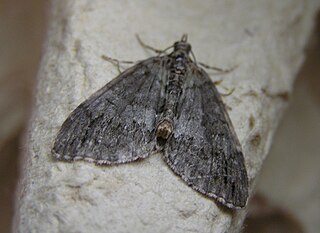
Hydriomena is a genus of moths in the family Geometridae described by Jacob Hübner in 1825.
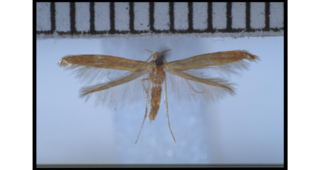
Batrachedra litterata is a species of moth in the family Batrachedridae. It is endemic to New Zealand and has been collected in the North and South Islands. This species has been reared on the fern species Blechnum chambersii. Adults are on the wing in November and December.
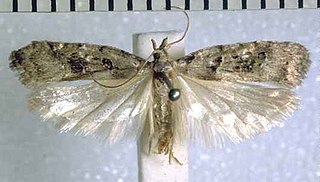
Heterocrossa canescens is a species of moth in the family Carposinidae. It is endemic to New Zealand. This species has been observed in Aoraki / Mount Cook National Park and in the Southern Alps. The larvae of this species feed on the fruits and flowers of endemic to New Zealand species in the genus Gaultheria. Adult moths are on the wing in November and from January to March.

Heterocrossa ignobilis is a species of moth in the family Carposinidae. It was described by Alfred Philpott and is endemic to New Zealand and has been observed in Canterbury, in the South Island. Adults are on the wing in January.

Scoparia scripta is a species of moth in the family Crambidae. It is endemic in New Zealand and has been observed in the southern half of the South Island including in the Hunter Mountains and at Otira, Arthur's Pass and Mt Titiroa as well as in Deep Creek and Coronet Creek valleys near Coronet Peak. The species inhabits damp gullies. Adults are on the wing from January to March. Larvae feed on Epilobium species.

Trachypepla semilauta is a moth of the family Oecophoridae and was first described by Alfred Philpott in 1918. It is endemic to New Zealand and has been collected in Southland. This species inhabits southern beech forest on the side of mountains. Adults are on the wing in January.

Heterocrossa is a genus of moths in the Carposinidae family. It is endemic to New Zealand. This genus was previously regarded as a synonym of the genus Carposina. However Elwood C. Zimmerman in Insects of Hawaii removed Heterocrossa from synonymy with Carposina. Zimmerman argued that as the genitalia of Heterocrossa and Carposina are distinct, Heterocrossa should not be regarded as a synonym of Carposina. This was agreed with by John S. Dugdale in his annotated catalogue of New Zealand Lepidoptera.

Sagephora exsanguis is a species of moth in the family Tineidae. It was described by Alfred Philpott in 1918. This species is endemic to New Zealand and has been found on Cuvier Island, as well as the North and South Islands. The adults of this species are on the wing from October to December.
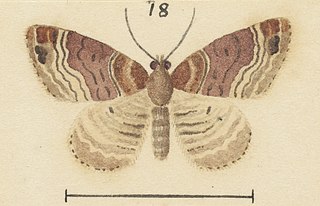
Hydriomena iolanthe is a species of moth in the family Geometridae. It is indigenous to New Zealand. This species is based on a single specimen that is now lost and has not been matched to any known species. As such it is classified as data deficient by the Department of Conservation.
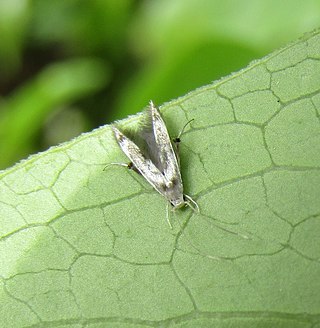
Thylacosceles cerata is a moth of the family Stathmopodidae. This species is endemic to New Zealand. It was first described by Alfred Philpott in 1918.
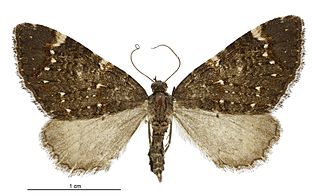
Hydriomena arida is a species of moth in the family Geometridae. This species is endemic to New Zealand. It has been hypothesised that species belongs to another genus and so this species is also currently known as Hydriomena (s.l.) arida.
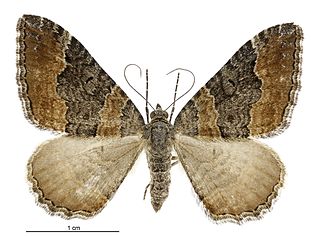
Hydriomena deltoidata is a species of moth in the family Geometridae. It was first described by Francis Walker in 1862. This species is endemic to New Zealand. The classification of New Zealand endemic moths within the genus Hydriomena is regarded as unsatisfactory and in need of revision. As such this species is currently also known as Hydriomena (s.l.) deltoidata. The adults of this moth are known to pollinate Dracophyllum acerosum and Leptospermum scoparium.
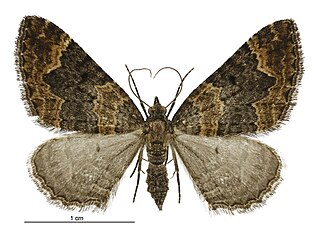
Hydriomena hemizona is a species of moth in the family Geometridae. It was first described by Edward Meyrick in 1897. This species is endemic to New Zealand. The classification of New Zealand endemic moths within the genus Hydriomena is regarded as unsatisfactory and in need of revision. As such this species is currently also known as Hydriomena (s.l.) hemizona.
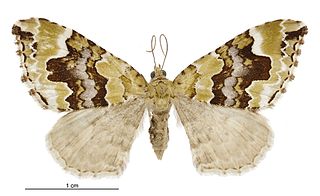
Hydriomena purpurifera is a species of moth in the family Geometridae. It was first described by Richard William Fereday in 1883. This species is endemic to New Zealand. The classification of New Zealand endemic moths within the genus Hydriomena is regarded as unsatisfactory and in need of revision. As such this species is currently also known as Hydriomena (s.l.) purpurifera.
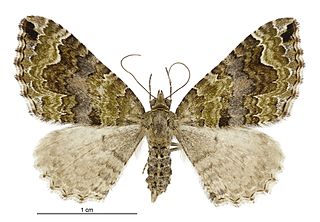
Hydriomena rixata is a species of moth in the family Geometridae. It was first described in 1875. This species is endemic to New Zealand. The classification of New Zealand endemic moths within the genus Hydriomena is regarded as unsatisfactory and in need of revision. As such this species is currently also known as Hydriomena (s.l.) rixata. The adults of this moth are known to pollinate Dracophyllum acerosum.

Tatosoma fasciata is a species of moth in the family Geometridae first described by Alfred Philpott in 1914. It is endemic to New Zealand. This moth has been observed at Mount Te Aroha, which is possibly the northern most location this species is found. The larval host plant of this species is Lophozonia menziesii.

Atomotricha lewisi is a moth in the family Oecophoridae. This speceis was first described by Alfred Philpott in 1927 and is endemic to New Zealand. This species has been observed in Central Otago and the Mackenzie Country. The larvae are believed to be soil dwelling with the adults emerging during the winter months of May and June. The female of the species is short winged and flightless and the male of the species have been observed on the wing in August and September.

Trachypepla ingenua is a moth of the family Oecophoridae first described by Edward Meyrick in 1911. It is endemic to New Zealand and has been collected in both the North and South Islands. This species is one of the larger in the genus Trachypepla and the colouration of the adults imitates bird droppings. The preferred habitat of T. ingenua is native forest and adults are on the wing from December to February.

Chrysorthenches polita is a species of moth in the family Plutellidae. It was first described by Alfred Philpott in 1918. It is endemic to New Zealand and it has been observed in both the North and South Islands. This species likely has two broods a year with one emerging in late spring and other in summer. The larvae mine leaves of Podocarpus species including Podocarpus totara. Adults have been observed on the wing in July to October and December to March.

Scythris nigra is a species of moth in the family Scythrididae first described by Alfred Philpott in 1931. It is endemic to New Zealand. The larvae of this species feeds on Hebe odora. The adults are day flying and on the wing in December.




















